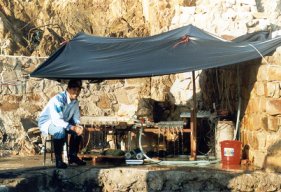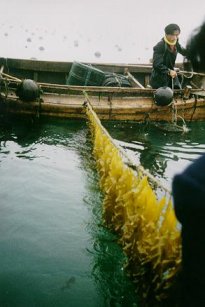Methodologies
Carrying capacity and impact of aquaculture on the environment in Chinese bays
INCO-DC contract Nš ERBIC4CT 98-0291
|
|
We studied and modeled aquaculture in two bays; Jiaozhou and Sanggou, both in Shandong
Province, in Northern China.
A metadatabase was first constructed that synthesised existing data from historical records, statistics for mariculture production, available databases and spatial information both on cultivated species and hydrobiological characteristics. |
From May 1999 to April 2000, data required for calibrating and groundtruthing our models were obtained through additional field work in the natural environment (in situ spatial and temporal variability in natural environmental variables, measured monthly at seven stations in each bay), including studies of the cultivated species (stock assessment, population dynamics, growth), as well as interactions between those species and the environment (ecophysiology experiments). |
|
| Findings define the effects of temperature, nitrogen availability and light intensity on growth of the main cultured macroalgae,
Laminaria japonica.
In addition, for the main species of cultured shellfish, the Chinese scallop
Chlamys farreri, the Manila clam Ruditapes philippinarum and the Pacific oyster
Crassostrea gigas, we have developed separate dynamic models that replicate responsive adjustments in feeding, metabolism and growth across full natural ranges of temperature, food availability and food composition. |
|
At the local farm scale, towards a practical tool that can be used locally by marine farmers to predict the effects of culture density upon shellfish growth at different sites, we have developed a depletion model which couples our models of shellfish ecophysiology with a one-dimensional horizontal transport formulation. |
|
| At wider bay scales, two complementary strategies were employed to assess environmental carrying capacities for culture, taking into account interactions between each cultivated species, as well as between those species and their environments.
Firstly, a 2D coupled physical-biogeochemical model was developed for Sanggou Bay, based on a bathymetric grid of 1120 cells affording a spatial resolution of 500 m, to simulate short term responses (e.g. one year) to changes in cultivation practice.
Secondly, a box model was developed using a quasi one-dimensional approach without spatial variability to assess effects of culture practice on production in the longer term. Both of these bay scale models accounted for primary production, bivalve and kelp ecophysiology and growth, exchange with the ocean, mineralisation of detritus, particle sedimentation and resuspension, species densities, and times of seeding and harvesting. |
|
By these means, integrated assessments were undertaken to consider how different scenarios of multi-species culture may affect ecosystem functioning and sustainable capacities for exploitation. The scenarios were recommended by local fisheries managers, and the outputs considered collectively in associated workshops, as significant contributions in the development of local fisheries practice. |
|


